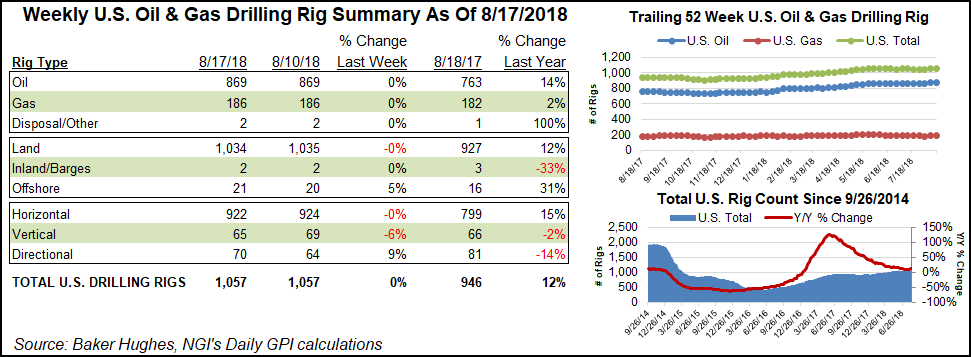Infrastructure | E&P | NGI All News Access
No Change to Natural Gas Rigs as BHGE’s U.S. Count Steady
Domestic natural gas drilling activity held steady during the week ended Friday as the combined U.S. rig count took a pause following the previous week’s big gains, according to data from Baker Hughes, a GE Company (BHGE).

Both oil- and natural gas-directed drilling finished even on the week at 869 rigs and 186 rigs, respectively, keeping total domestic rigs at 1,057 for the week ended Aug. 17. Six directional units returned to action, offsetting the loss of four vertical and two horizontal units. The number of gas rigs are roughly in line with the year-ago total of 182, while oil activity is up more than 100 rigs from 763 active units at this time last year, according to BHGE.
Domestic land drilling dropped by one rig week/week (w/w), while the Gulf of Mexico added a rig to increase its latest tally to 19.
Canada added three rigs for the week, two gas and one oil, finishing at 212, in line with 214 rigs in the year-ago period. The combined North American rig count finished the week at 1,269, up from 1,160 a year ago.

Among plays, the Permian Basin, the Marcellus Shale and the Arkoma Woodford each netted one rig w/w. Meanwhile, the Cana Woodford posted the largest net decline, as three rigs exited the play.
A more detailed breakdown of Cana Woodford activity by NGI’s Shale Daily shows the South Central Oklahoma Oil Province (aka, the SCOOP) dropping two rigs w/w, with the Sooner Trend of the Anadarko Basin, mostly in Canadian and Kingfisher counties (aka, the STACK), dropping one.
Among states, Texas led the way among gainers, adding three rigs to finish at 525 (459 a year ago), followed by Pennsylvania and Louisiana, which each added two rigs w/w.
New Mexico, which overlies part of the Permian Basin along with West Texas, saw three rigs depart for the week to finish at 104, still well above its year-ago tally of 62. Ohio, West Virginia, Wyoming and Alaska each dropped one rig w/w, according to BHGE.
In terms of foreshadowing where new rigs might pop up in the near future, drilling permit activity trended sharply higher in Ohio and North Dakota in July, as Colorado, Texas and Wyoming saw declines, according to Evercore ISI analysts led by James West.
During July, a total of 3,600 permits to drill onshore in the United States were issued, down 28% from June but 8% higher than a year ago, Evercore’s monthly report indicated.
Permit numbers were weaker in July versus June in Wyoming (down 39%), Colorado (down 45%) and Texas (down 23%), but the declines were partially offset by a strong gain in Ohio, which saw a 120% month/month surge, and in North Dakota, with permits up 14%.
Meanwhile, oil and natural gas operators in North Dakota’s Bakken Shale applied the brakes to production in June, the state’s director of the Department of Mineral Resources said Thursday. Lynn Helms attributed the monthly decreases to natural gas capture challenges, weather and a continuing shortage of hydraulic fracturing crews.
“The industry hasn’t taken its foot off the accelerator, but it was definitely tapping the brakes in June with a 21,000 b/d decrease, about 2%,” Helms said during a monthly webinar. However, the state set a new record for producing wells in June, reaching 14,778, despite dropping eight rigs.
“There are a record number of wells producing, but the operators are restricting the production from some of them,” he said.
© 2024 Natural Gas Intelligence. All rights reserved.
ISSN © 1532-1231 | ISSN © 2577-9877 |
